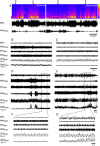Hypercapnia-induced active expiration increases in sleep and enhances ventilation in unanaesthetized rats
- PMID: 28776683
- PMCID: PMC6068213
- DOI: 10.1113/JP274726
Hypercapnia-induced active expiration increases in sleep and enhances ventilation in unanaesthetized rats
Abstract
Key points: Expiratory muscles (abdominal and thoracic) can be recruited when respiratory drive increases under conditions of increased respiratory demand such as hypercapnia. Studying hypercapnia-induced active expiration in unanaesthetized rats importantly contributes to the understanding of how the control system is integrated in vivo in freely moving animals. In unanaesthetized rats, hypercapnia-induced active expiration was not always recruited either in wakefulness or in sleep, suggesting that additional factors influence the recruitment of active expiration. The pattern of abdominal muscle recruitment varied in a state-dependent manner with active expiration being more predominant in the sleep state than in quiet wakefulness. Pulmonary ventilation was enhanced in periods with active expiration compared to periods without it.
Abstract: Expiration is passive at rest but becomes active through recruitment of abdominal muscles under increased respiratory drive. Hypercapnia-induced active expiration has not been well explored in unanaesthetized rats. We hypothesized that (i) CO2 -evoked active expiration is recruited in a state-dependent manner, i.e. differently in sleep or wakefulness, and (ii) recruitment of active expiration enhances ventilation, hence having an important functional role in meeting metabolic demand. To test these hypotheses, Wistar rats (280-330 g) were implanted with electrodes for EEG and electromyography EMG of the neck, diaphragm (DIA) and abdominal (ABD) muscles. Active expiratory events were considered as rhythmic ABDEMG activity interposed to DIAEMG . Animals were exposed to room air followed by hypercapnia (7% CO2 ) with EEG, EMG and ventilation ( ) recorded throughout the experimental protocol. No active expiration was observed during room air exposure. During hypercapnia, CO2 -evoked active expiration was predominantly recruited during non-rapid eye movement sleep. Its increased occurrence during sleep was evidenced by the decreased DIA-to-ADB ratio (1:1 ratio means that each DIA event is followed by an ABD event, indicating a high occurrence of ABD activity). Moreover, was also enhanced (P < 0.05) in periods with active expiration. had a positive correlation (P < 0.05) with the peak amplitude of ABDEMG activity. The data demonstrate strongly that hypercapnia-induced active expiration increases during sleep and provides an important functional role to support in conditions of increased respiratory demand.
Keywords: EEG; EMG; breathing control; expiratory activity; sleep; wakefulness.
© 2017 The Authors. The Journal of Physiology © 2017 The Physiological Society.
Figures





Comment in
-
Sleep awakens active expiration.J Physiol. 2018 Aug;596(15):2947-2948. doi: 10.1113/JP275056. Epub 2017 Sep 2. J Physiol. 2018. PMID: 28833135 Free PMC article. No abstract available.
Similar articles
-
Differential modulation of active expiration during hypercapnia by the medullary raphe in unanesthetized rats.Pflugers Arch. 2020 Nov;472(11):1563-1576. doi: 10.1007/s00424-020-02455-5. Epub 2020 Sep 11. Pflugers Arch. 2020. PMID: 32914212
-
Respiratory and Metabolic Effects of Active Expiration in Freely Behaving Rats.Acta Physiol (Oxf). 2025 Sep;241(9):e70084. doi: 10.1111/apha.70084. Acta Physiol (Oxf). 2025. PMID: 40728246 Free PMC article.
-
Non-chemosensitive parafacial neurons simultaneously regulate active expiration and airway patency under hypercapnia in rats.J Physiol. 2017 Mar 15;595(6):2043-2064. doi: 10.1113/JP273335. Epub 2017 Feb 1. J Physiol. 2017. PMID: 28004411 Free PMC article.
-
The parafacial respiratory group and the control of active expiration.Respir Physiol Neurobiol. 2019 Jul;265:153-160. doi: 10.1016/j.resp.2018.06.010. Epub 2018 Jun 19. Respir Physiol Neurobiol. 2019. PMID: 29933053 Review.
-
Breathing around the clock: an overview of the circadian pattern of respiration.Eur J Appl Physiol. 2004 Mar;91(2-3):119-29. doi: 10.1007/s00421-003-0978-0. Epub 2003 Oct 21. Eur J Appl Physiol. 2004. PMID: 14569400 Review.
Cited by
-
Cholinergic modulation of upper airway control: maturational changes and mechanisms at cellular and synaptic levels.J Neurophysiol. 2025 Jan 1;133(1):46-59. doi: 10.1152/jn.00165.2024. Epub 2024 Nov 28. J Neurophysiol. 2025. PMID: 39607299 Free PMC article. Review.
-
Inhibitory control of active expiration by the Bötzinger complex in rats.J Physiol. 2020 Nov;598(21):4969-4994. doi: 10.1113/JP280243. Epub 2020 Jul 24. J Physiol. 2020. PMID: 32621515 Free PMC article.
-
Mapping responses to focal injections of bicuculline in the lateral parafacial region identifies core regions for maximal generation of active expiration.Elife. 2024 Jul 17;13:RP94276. doi: 10.7554/eLife.94276. Elife. 2024. PMID: 39017665 Free PMC article.
-
Chemogenetic modulation of the parafacial respiratory group influences the recruitment of abdominal activity during REM sleep.Sleep. 2020 May 12;43(5):zsz283. doi: 10.1093/sleep/zsz283. Sleep. 2020. PMID: 31747042 Free PMC article.
-
Central respiratory chemoreception.Handb Clin Neurol. 2022;188:37-72. doi: 10.1016/B978-0-323-91534-2.00007-2. Handb Clin Neurol. 2022. PMID: 35965033 Free PMC article. Review.
References
-
- Abe T, Kusuhara N, Yoshimura N, Tomita T & Easton PA (1996). Differential respiratory activity of four abdominal muscles in humans. J Appl Physiol 80, 1379–1389. - PubMed
-
- Badr MS, Skatrud JB, Dempsey JA & Begle RL (1990). Effect of mechanical loading on expiratory and inspiratory muscle activity during NREM sleep. J Appl Physiol 68, 1195–1202. - PubMed
-
- Bartlett D & Tenney SM (1970). Control of breathing in experimental anemia. Respir Physiol 10, 384–395. - PubMed
Publication types
MeSH terms
Grants and funding
LinkOut - more resources
Full Text Sources
Other Literature Sources

